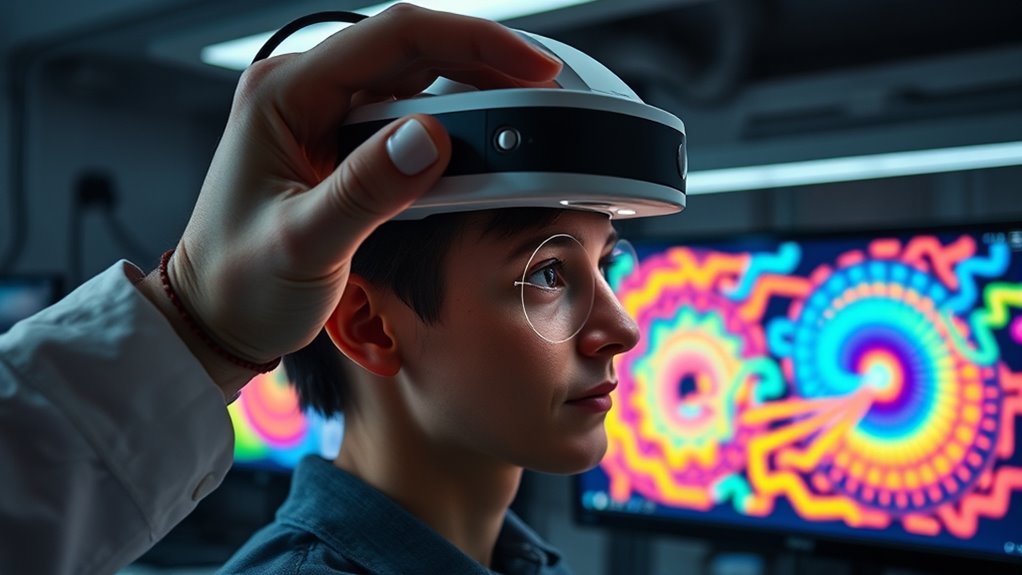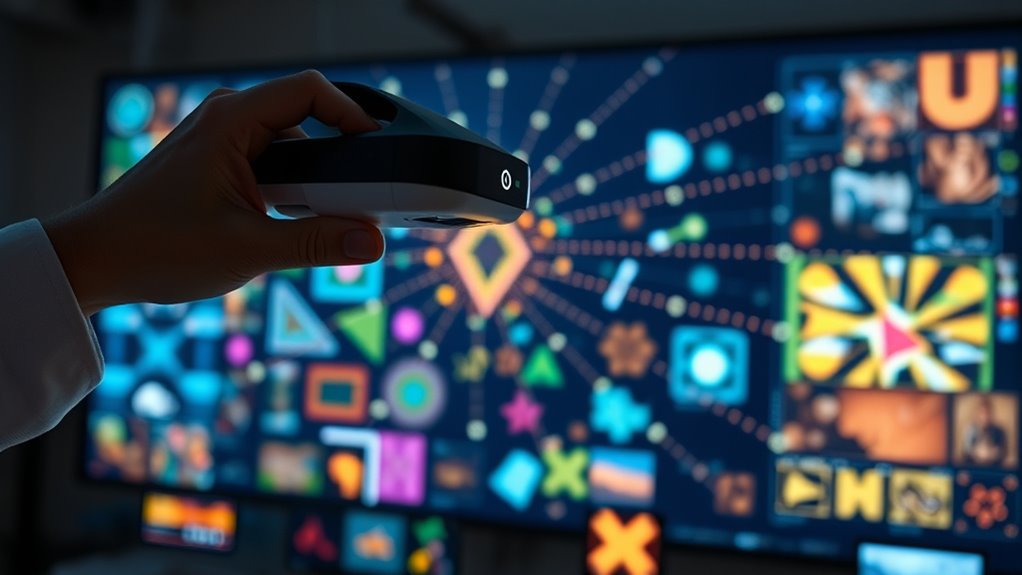Understanding visual search and eye-tracking helps you see how people focus on specific objects, filter visual information, and make quick decisions. Eye-tracking captures eye movements like fixations and saccades, revealing what draws attention and how efficiently someone processes a scene. Combining neural and cultural insights, researchers explore different search strategies and behaviors. If you keep exploring, you’ll uncover how these tools reveal the complex interplay between perception, attention, and culture in visual tasks.
Key Takeaways
- Visual search involves scanning for specific objects using attention, guided by visual cues, memory, and decision-making processes.
- Eye-tracking captures real-time eye movements to analyze attention focus, gaze patterns, and cognitive load during visual tasks.
- Neural pathways regulate attention, with cultural backgrounds influencing gaze patterns and search strategies across different populations.
- Eye-tracking metrics like fixation duration and saccade length reveal information processing efficiency and areas of interest.
- Future advancements integrate machine learning and neuroimaging to deepen understanding of neural and cultural influences on visual search.
The Basics of Visual Search

Visual search is the process of scanning your environment to find a specific object or feature among many distractions. During this task, your visual attention focuses on relevant details, filtering out irrelevant information. This selective attention is vital for efficient visual search, allowing you to quickly locate what you’re looking for. Underlying this process are complex cognitive processes that coordinate perception, memory, and decision-making. You actively interpret visual cues, compare them to stored mental representations, and decide where to look next. Your brain continuously updates its understanding of the scene, guiding your eye movements toward potential targets. This combination of visual attention and cognitive processes makes visual search a dynamic, purposeful activity essential for everyday tasks like reading, driving, or navigating crowded spaces.
How Eye-Tracking Works

Eye-tracking technology captures where and how your eyes move as you look at a scene or object. It tracks your gaze patterns by using sensors or cameras that record eye positions and movements in real time. These sensors detect tiny movements called saccades and fixations, revealing where your attention is focused. The data collected allows for attention mapping, which visually shows which areas draw your eyes most often. This process helps researchers understand what captures your interest and how you process visual information. By analyzing gaze patterns, we can identify key visual elements and optimize designs, interfaces, or layouts for better engagement. Eye-tracking works by translating your eye movements into digital signals, creating a detailed map of your visual attention. Additionally, understanding powerful persuasive words can enhance the effectiveness of visual communication and influence viewer engagement. Recognizing the benefits of glycolic acid exfoliation can also inform the development of more effective skincare visual content, making it more appealing to viewers. The integration of advanced AI technologies, such as generative AI, is also beginning to influence how visual data is analyzed and interpreted, leading to more sophisticated insights. Moreover, the use of automation in business can streamline data collection and analysis processes, making eye-tracking studies more efficient and scalable. Incorporating headphones into visual studies can help researchers deliver consistent audio cues, improving the overall reliability of attention data.
Applications of Visual Search and Eye-Tracking
The applications of visual search and eye-tracking span across various fields, helping professionals improve design, usability, and marketing strategies. In augmented reality, eye-tracking enables more immersive experiences by understanding where users focus, allowing developers to optimize content placement and interaction. Marketers leverage eye-tracking data to analyze how consumers view advertisements, websites, and product displays, refining their strategies for maximum engagement. This technology helps identify which elements attract attention first and how long users spend on specific areas, guiding layout adjustments. Eye-tracking also supports personalized experiences by adapting content based on user attention patterns. Additionally, understanding prophetic dreams can provide insights into subconscious influences that affect perception and decision-making. Overall, these applications enhance user experience, increase engagement, and boost effectiveness across digital platforms, making visual search and eye-tracking essential tools in today’s innovation-driven landscape.
Insights Gained From Eye Movement Studies

By analyzing eye movement data, researchers uncover valuable insights into how you interact with digital content. Gaze patterns reveal where your attention naturally focuses and how efficiently you process information. For example:
- Your eyes often jump between key areas, highlighting important content.
- Longer fixations indicate difficulty or high cognitive load.
- Short, quick saccades suggest familiarity or effortless recognition.
- Patterns of back-and-forth movements reveal areas of confusion or interest.
- Understanding store hours helps in planning efficient shopping trips and reducing frustration.
These insights help designers optimize layouts to reduce cognitive load and improve usability. Understanding gaze patterns allows you to identify which elements draw your attention and where you might experience overload. Additionally, eye-tracking data can inform personal development strategies by revealing how users engage with visual content and how their focus shifts over time. Recognizing visual attention patterns enables content creators to tailor their designs for better engagement. Ultimately, eye-tracking uncovers how your visual attention shapes your overall digital experience, providing a clearer picture of human interaction with visual content.
Future Directions in Visual Attention Research

As technology advances, researchers are exploring innovative ways to deepen our understanding of visual attention, integrating methods like machine learning, augmented reality, and real-time data analysis. These tools allow us to investigate neural mechanisms underlying attention more precisely, revealing how specific brain regions coordinate during visual search tasks. Future research will also focus on cross-cultural differences, examining how cultural backgrounds influence attention patterns and eye movement behaviors. By combining neuroimaging with eye-tracking data, you can uncover how cultural factors shape neural responses involved in attention allocation. Additionally, the integration of AI-powered analysis enhances the ability to interpret complex eye movement patterns, leading to more personalized and effective applications. Incorporating remote work environments into research can provide insights into how different settings impact visual attention and focus. Recognizing the importance of retail environments, studies may also explore how eye-tracking can optimize store layouts and marketing strategies. Furthermore, understanding the Gold IRA options available can inform future financial decision-making related to investment behaviors. Emerging research on soulmate angel numbers can also shed light on subconscious cues that influence attention and perception, providing a broader understanding of how symbolic patterns guide focus. This integrated approach promises to enhance personalized interfaces, improve diagnostic tools, and expand our understanding of the complex interplay between neural mechanisms and cultural influences in visual attention.
Frequently Asked Questions
How Can Visual Search Improve User Interface Design?
Visual search can substantially improve your user interface design by helping you apply design heuristics that enhance clarity and usability. When you optimize how users visually explore your interface, you boost user engagement and make navigation intuitive. By understanding where users focus and how they scan, you can create layouts that guide their attention effectively, resulting in a more seamless experience and increased satisfaction with your digital product.
What Are Common Challenges in Eye-Tracking Accuracy?
Imagine your eyes as a camera trying to capture a perfect shot; calibration issues can blur that image, leading to inaccuracies. You might face challenges like participant variability, where different users’ eye movements differ due to factors like fatigue or lighting. These issues make it tough to get precise data, requiring careful calibration and consideration of individual differences to improve eye-tracking accuracy and guarantee reliable insights.
Can Eye-Tracking Detect Emotional Responses?
You might wonder if eye-tracking can detect emotional responses. While it primarily measures visual attention, it also aids in emotional detection by analyzing responses like pupil dilation, blink rate, and gaze patterns. These metrics serve as response measurement tools, giving insights into your emotional state during viewing. So, yes, eye-tracking can indirectly reveal emotions, helping researchers understand how you respond emotionally to visual stimuli.
How Does Age Affect Visual Search Patterns?
Did you know that age influences how you search visually? As you get older, there’s often an age-related decline in visual search efficiency, making it harder to locate objects quickly. Developmental differences mean younger individuals tend to scan environments more rapidly and systematically, while older adults may show slower, more cautious patterns. These changes reflect natural shifts in visual processing abilities, highlighting how your age shapes the way you explore and interpret your surroundings.
What Ethical Considerations Exist in Eye-Tracking Research?
When conducting eye-tracking research, you need to consider ethical issues like privacy concerns and informed consent. You should ensure participants fully understand how their data will be used and stored, protecting their personal information. It’s essential to obtain clear consent before starting, and you must handle data responsibly to respect participants’ rights and maintain trust. Addressing these ethical considerations safeguards both participants and the integrity of your research.
Conclusion
By exploring visual search and eye-tracking, you discover how your attention works in real time. Did you know that people only see about 20% of what’s in their visual field clearly? Eye-tracking reveals patterns that can improve everything from website design to safety protocols. As technology advances, you’ll gain even deeper insights into human behavior, making your understanding of visual attention more precise and impactful. The future of visual search is truly exciting!





